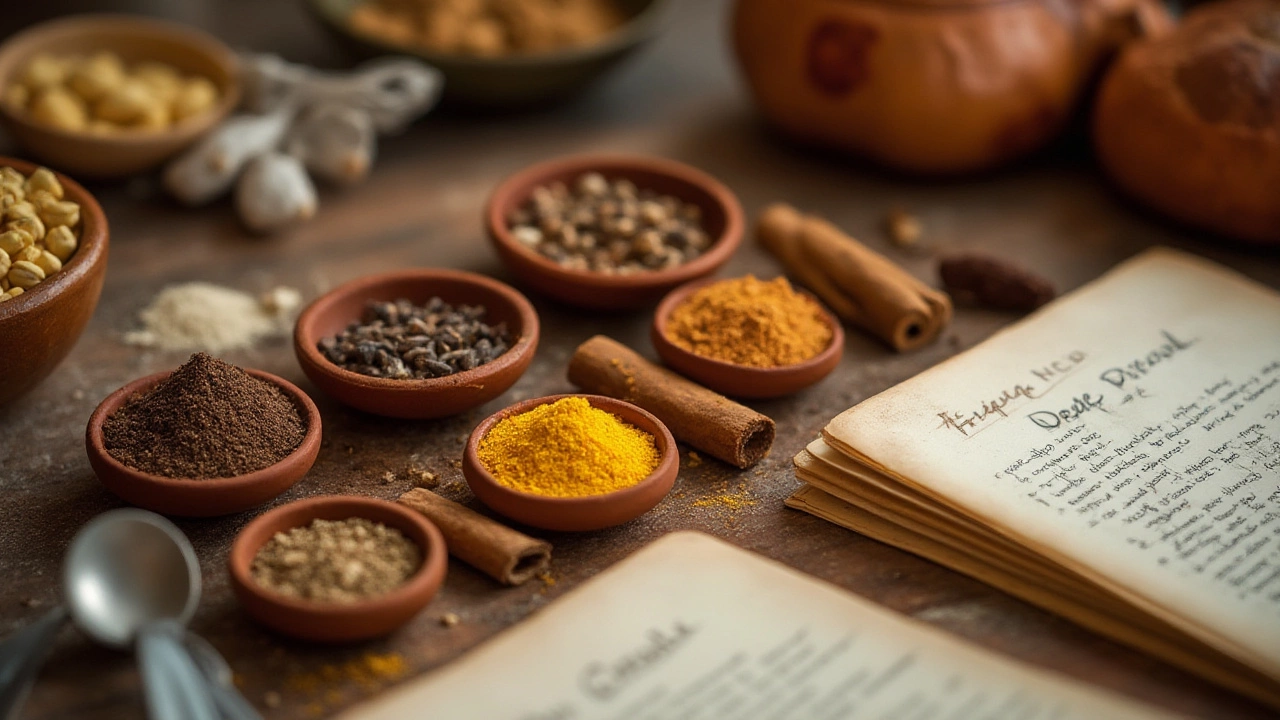Ever wondered how a simple stew transforms into an unforgettable curry? It's all about the spice magic. No two curries taste alike, and that's thanks to the rainbow of spices swirling around in each pot. Some curries hit you with bold warmth, others dance through fragrant sweetness, and a few pack enough punch to tear up the timid. Spices unlock this universe, one pinch at a time. Here’s where things get really interesting: you don’t need an entire apothecary to craft a brilliant curry, but understanding which spices do what—and how to coax out their best sides—makes all the difference between a curry that whispers and one that sings.
The Essential Spices Every Curry Needs
Walk into any Indian kitchen, and you've probably seen the classic masala dabba—a spice box packed with must-haves. The core spices for curry start simple but can transform anything you’re cooking. At the heart, you’ll find turmeric, cumin, coriander, chili powder, and mustard seeds. Turmeric offers that gorgeous gold color and subtle earthiness. Cumin seeds, when tossed hot in oil, unleash a nutty aroma that’s familiar in hundreds of dishes. Coriander—both seeds and ground—brings a mellow, citrusy flavor. These three often form the flavor base, setting the tone for everything else.
Chili powder or whole dried chilies decide the heat level. Indian red chili powder is pure fire, but not just about pain—it brings color and a gentle smoky sweetness. Black mustard seeds pop in hot oil with a nutty sharpness, especially key in South Indian curries. Toss in fenugreek, and you get a deep, maple-ish bitterness that underpins dishes like methi chicken. And don’t skip bay leaves or cassia bark (Indian cousin to cinnamon) for a bass note of warmth. If you think Indian cuisine cannot surprise, try fenugreek—in large amounts, it’s bitter, but in the right dose, it tastes almost like caramel.
Here’s a quick table that spells out the flavor profile and typical role for each essential spice:
| Spice | Flavor Profile | Main Use in Curry |
|---|---|---|
| Turmeric | Earthy, slightly bitter | Color, earthy base |
| Cumin | Warm, nutty | Aroma, base spice |
| Coriander | Citrusy, slightly sweet | Body, balance |
| Red Chili Powder | Hot, slightly smoky | Heat, redness |
| Mustard Seeds | Sharp, nutty | Tempering oil, flavor twist |
| Fenugreek | Bitter, maple-like | Depth, complexity |
Always toast whole spices in oil or dry-roast them—the scent hits your nose before it even hits your taste buds. That toasting step changes everything. Toasted cumin? Yes, please!
Spice Blends and Garam Masala: The Secret Weapons
Garam masala is the secret handshake of Indian cooking. It’s not one spice but a mix, usually ground after roasting cinnamon, cardamom, cloves, black peppercorns, and nutmeg. Every family recipe is a little different—some are heavy on cumin, others spike up with mace or star anise. But what does it do? It wakes up your curry at the end of cooking, giving warmth and complexity without competing with the main ingredients.
The cool thing about garam masala? Add it in the last five minutes—never at the start. This keeps the flavors bright and aromatic. If you add too early, the perfume can vanish into thin air. Some folks skip garam masala and just use ‘curry powder’ (which, honestly, isn’t a thing in most Indian homes—it’s more of a British shortcut). If you use curry powder, check the label: turmeric and coriander are common bases, followed by cinnamon, fenugreek, and black pepper.
Madras curry powder is a spicy blend many swear by for red, tangy curries. It typically has more chili, mustard seed, and fenugreek than basic curry powder. There’s also sambar powder (great for lentils and veggies), chaat masala (fruity, tangy, best for cold or snack curries), and tandoori masala (paprika-heavy, for grilled flavors).
- TIP: Mix your own garam masala for better control. Toast the spices gently, grind, and store in an airtight jar. Friends will ask your secret.
- If you’re gluten-free or sensitive to additives, blending your own helps skip mystery fillers often found in grocery-store mixes.
Bought a blend that’s too harsh or too mild? Tweak it: Add a touch of nutmeg for sweetness or more black pepper for extra heat. This is your kitchen—play around.

Regional Tricks: North, South, East, and West
Curry tastes wildly different depending on where you are in India. A North Indian butter chicken leans rich and creamy, all tomato and garam masala. South Indian curries flirt with coconut milk, curry leaves, mustard seeds, and always a good dose of heat. Walk through the East and you’ll bump into panch phoron—a five-spice blend with fennel, nigella, fenugreek, cumin, and mustard seeds—used to spark up vegetables and lentils. Head West, and sometimes, you get curries spiced with dry kokum, cardamom, or even peanuts for body.
Curry leaves aren’t actually a spice—they’re more like a herb, but their nutty, citrus zing is irreplaceable in southern dishes. Fry them until crisp, and they perfume the oil for coconutty, tangy curries. In Goa, Kashmiri chili powder offers gentle heat and that brick-red hue, while black cardamom adds smoky, savory bass notes in robust lamb stews from the hills of North India. Marathi goda masala is a lesser-known blend adding roasted coconut and sesame for a sweet-savory punch.
- Panch phoron is never ground—always used whole in hot oil at the start for tempering a curry.
- Coconut and poppy seeds often support spices in mild Bengali curry sauces, giving a creamy body without overpowering chili.
- Mustard oil is common in eastern curries—its peppery, pungent aroma lifts up fish or potato curries instantly.
Don’t be shy about experimenting with these. For a South Indian twist, try swapping garam masala for sambar powder, add curry leaves, and finish with a squeeze of lime. You’ll be amazed at the transformation.
Balancing Flavors: Ratios, To Dos, and Epic Fails
Spices don’t play solo—they’re all about harmonies and layers. If you load up your curry with just chili powder, you’ll get heat but not depth. Coriander and cumin mellow out turmeric’s bitterness, and ginger or garlic adds bite. One of the best-kept secrets? Always bloom ground spices in oil with onion, ginger, and garlic. This forms a deep base that carries flavors throughout the dish.
Here’s a starting point for basic curry powder: 2 parts coriander, 1 part cumin, 1/2 part turmeric, 1/2 part chili powder, and 1/4 part black pepper. Taste, then tweak. Got too much heat? Stir in yogurt or coconut milk to calm down the fire. Curry too bitter? A dash of sugar, a tomato, or lime juice balances things quickly. And if you’ve ever wondered why restaurant curries feel more luxurious, the answer is often in the slow simmer—let those spices mingle and develop.
Common epic fails include: dumping in spices at the end (they taste raw or chalky), burning them in too-hot oil (bitter disaster), or under-spicing (bland city). Keep some water handy—if things get too dry, you can loosen the masala without burning the goods. If you want a flavor bomb, toast whole spices first, then grind them for maximum punch—much stronger than using straight-from-the-bottle preground powders.
Pro move: Add a pinch of asafoetida (hing) when frying onions for earthy-sulfury oomph—just a tad, though! And don’t forget a splash of fresh lemon or chopped cilantro at the end to brighten the richness.

Modern Twists and Spice Shortcuts for Everyday Curry
Just because you're in a rush doesn’t mean your curry has to taste rushed. Some spice hacks can save the day and still turn out delicious. Frozen ginger-garlic cubes, ready-to-go curry leaves, or a jar of pre-blended garam masala can rescue busy weeknights, especially if you’re new to Indian cooking. Try smoked paprika for a gentle heat and smokiness, or ancho chili powder if you want mellow warmth without setting off the smoke alarm.
If you're avoiding oil, you can bloom spices in hot water or stock before adding to your curry base. It’s not quite the same as toasting in oil, but it works in a pinch and keeps the flavors lively. Many cooks now grind small batches of custom masalas to avoid losing freshness. Store them in small jars, label them, and pull out your favorite for specific dishes—like chana masala or korma. Making spice blends ahead of time means you only dirty one spoon and avoid hunting down twenty jars while cooking.
- Curry paste can be a serious shortcut: just sauté it to release the flavors before adding liquid ingredients.
- Additions like dried fenugreek leaves (kasuri methi) or amchur (dried mango powder) offer new layers—herbal or tangy, in seconds.
- For the health-focused, swap coconut oil in place of ghee for nutty richness that’s dairy-free.
The world of curry spices is massive, but starting with the basics—coriander, cumin, turmeric, and spices for curry—unlocks endless possibility. Don’t let a long spice list put you off. Just a few well-chosen spices can turn your kitchen into the heart of an Indian home, wherever you are. Dive in, taste as you go, and trust your nose—curry-making is about following your senses as much as any recipe. The spice adventure honestly never ends.
